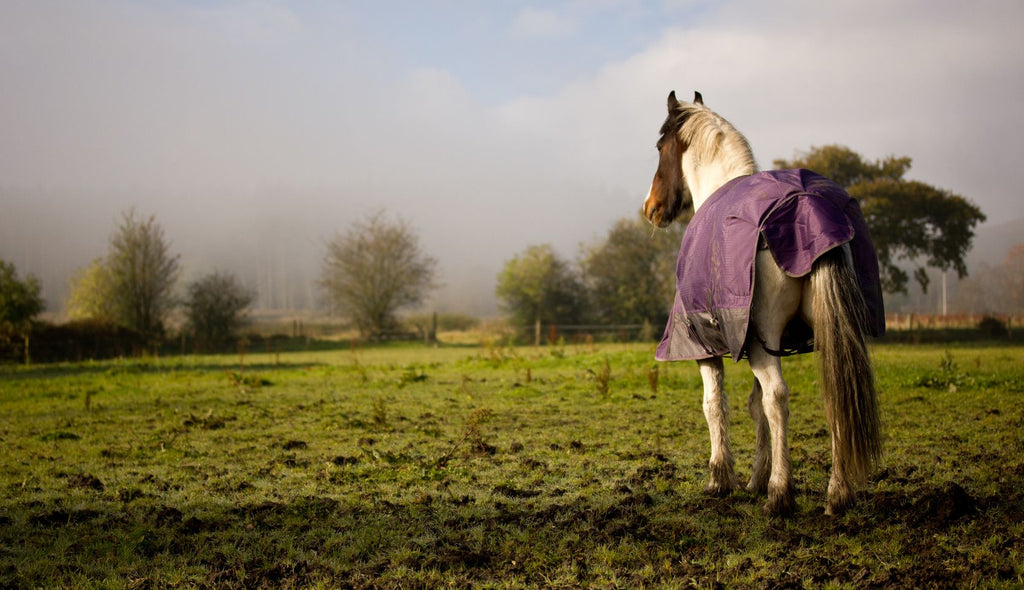Winter Equestrian Survival Guide: Staying Warm, Cosy and Happy with Your Horse

Winter can be magical - but let’s be honest, it’s also wet, muddy, and freezing. Whether you’re out feeding in the dark or tacking up for a ride in sideways rain, winter riding is no joke. Horses don’t get to hibernate, and neither do we!
So how do we make it through the season without turning into icicles or compromising our horse’s comfort and performance?
Here’s your essential guide to surviving winter as a rider:
Keeping Your Horse Comfortable in Winter
A Dry, Warm Shelter
Whether your horse is stabled or turned out, warmth starts with shelter. Make sure their stable or paddock shelter is dry, well-ventilated, and topped with a thick layer of straw or shavings.
Rugging Right
Clipped or not, your horse needs rugging that suits both their activity level and environment, particularly if they do not have a shelter in their paddocl. Use a waterproof outer rug for paddock protection, and a warm, breathable stable rug indoors. Don’t forget to switch rugs after heavy rain or if they have moisture build up underneath to prevent chills and skin issues.

Pro Tip: Add a BARE Wool Quarter Sheet to your tack-up for cold-day warmups or wear it throughout the ride for ongoing warmth. Handcrafted in Australia from mid-weight kersey wool, it’s durable, elegant, and perfectly practical.
Feeding for Warmth
Horses burn more calories staying warm in winter. Up their hay intake to keep their gut moving and body temp up. A 600kg horse typically needs 12–15kg of hay per day—and yes, that includes paddocked horses too, especially as grazing is usually limited in winter due to poor grass growth.
You might also need to top up feeds with cereals or hard feed, especially for working horses. And don’t forget minerals. Cold weather doesn’t mean skipping the good stuff.
Hydration Matters
Frozen water troughs are more than annoying—they’re dangerous. Make sure water sources are accessible and not iced over. Place a floating object like a wooden ball in the trough to help reduce surface freezing (make sure what you use is not small enough for your horse to ingest).
Warming Up & Cooling Down
Horses feel the cold in their muscles too. Start every ride with a proper warm-up—long walk sessions are perfect. After your ride, a slow cooldown helps regulate body temp and avoid stiffness.
Your Must-Have: Our BARE Wool Quarter Sheet keeps your horse and their muscles snug throughout your ride. Simply remove mid-ride and replace during your cool down, or if the weather is harsh or you’re planning on a low intensity ride, you can leave it on from start to finish.
Mud Management
High-traffic areas like gateways and around water troughs tend to become boggy fast. Deep, persistent mud can lead to hoof issues, pulled shoes, and skin infections like mud fever.
Here’s how to help:
- Lay down gravel, wood chips, or rubber matting in problem zones to improve drainage and create a more stable footing.
- Rotate gate access points if possible to reduce wear in one spot.
- Elevate water troughs slightly and ensure any overflow drains away from the standing area.
Leg & Hoof Care

Winter means wet, and that often means mud fever risks. Be sure to check your horse’s legs daily and keep them as dry as possible.
Why Extra Protection Matters in Winter
Cold, wet conditions make tissues more vulnerable to strain and impact. Ground surfaces are often more uneven, increasing the risk of brushing injuries during work or turnout.
That’s why our BARE AIR Carbon Brushing Boots are a smart addition to your winter riding gear. They’re designed to:
- Deliver reliable protection from brushing and impact injuries
- Stay secure and breathable thanks to strong double-lock straps and moisture-wicking lining
- Be quick-drying and easy to clean, ideal for winter conditions
- Pair perfectly with our Techno Wool Bell Boots for complete lower-leg coverage during paddock turnout or training
Taking extra care during the colder months helps reduce recovery time, prevent avoidable injuries, and keep your horse feeling their best through winter.
Watch Your Step
Slippery surfaces can be hazardous, especially with horses wearing shoes. Use sand or grit on icy or slick patches and avoid leading horses across slick areas that are wet or cold, where possible.
And for You? Brave the Cold Without Compromising Style
You don’t need to sacrifice style for comfort. Our winter jackets are rider-tested and weather-proof, so you can face the chill looking and feeling fabulous.
BARE Winter Jacket Picks:
- Charlotte: Waterproof, fleece-lined, and stylish enough for any arena.
- Hollie: Ultra warm with faux fur trim and a slimming silhouette—shower-repellent and breathable.
- Leah: Classic navy with cosy style and practicality in every seam.
- Candace: Lightweight yet waterproof, perfect for rainy-day feed ups or saddle time.
All are machine washable and feature our flattering, functional equestrian cut for warmth without the bulk. Add zippers in all the right places, generous hoods, and thoughtful details, and you’ve got a jacket you’ll live in.
Don’t Forget the Little Things
- Keep saddle pads and boots dry between uses. Damp gear leads to rubbing and discomfort.
- Deworm in winter to avoid stress-related weight loss.
- Regularly check for hidden injuries or signs of illness. Prevention is key.
Winter can be challenging, but with the right gear and preparation, you and your horse will stay comfortable and protected.
SHARE:
